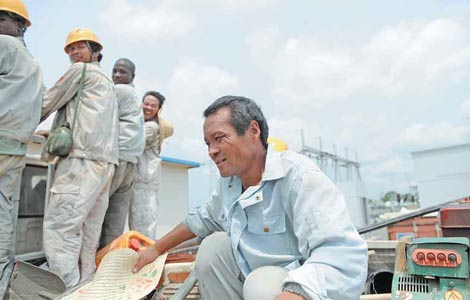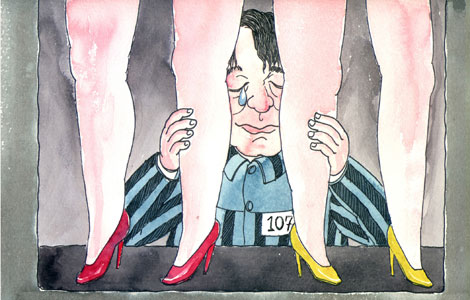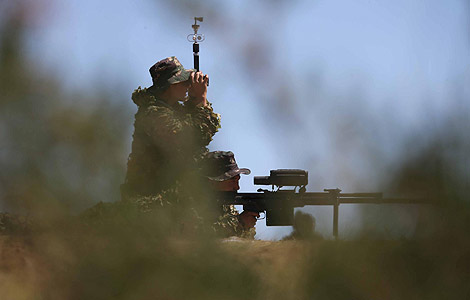Tougher plan to reduce air pollution
Updated: 2013-07-25 02:47
By Wu Wencong (China Daily)
|
|||||||||||
China's environment watchdog recently issued its most comprehensive and toughest plan to control and in some regions reduce air pollution by the year 2017, setting stricter limits on the levels of PM 2.5 particles.
Zhao Hualin, head of the pollution prevention and control department of the Ministry of Environmental Protection, said on Wednesday that the State Council approved the plan last month.
The Airborne Pollution Prevention and Control Action Plan (2013-17) will be the second plan to tackle pollution in the past two years and will be backed by 1,700 billion yuan ($277 billion) in total investments from the central government.
Zhao announced the State Council's approval during this week's 13th China International Environmental Protection Exhibition and Conference in Beijing.
Wang Jinnan, vice-president of the Chinese Academy for Environmental Planning, who participated in drafting the plan, said the new program will give priority to regions that have heavy air pollution and high levels of PM 2.5 — particulate matter that is 2.5 microns or less in diameter and that harms the respiratory system more than larger particles.
The new plan specifically targets North China, particularly Beijing, Tianjin and Hebei province. The plan's goal by 2017 is for a 25 percent reduction in air emissions from 2012 levels in that region.
Zhao said more details will be released in late July at the earliest.
"The Beijing, Tianjin and Hebei province area is the most stringently targeted because airborne pollution is most serious in this area," Wang said during the Eco-Forum Global Annual Conference on Saturday in Guiyang, Guizhou province.
A previous prevention plan on airborne pollution in 13 key areas of China was released in late 2012. Chai Fahe, vice-president of the Chinese Research Academy of Environmental Sciences, which is affiliated with China's Ministry of Environmental Protection, said the nation's top leaders realized that a tougher approach against air pollution was needed after releasing the plan in 2012.
Zhao said the latest plan is one of three key action plans that will be released over the next five years. The plans will address airborne pollution prevention, water pollution control and improvements to the rural environment.
Wang said that although eliminating outmoded methods of industrial production may have negative effects on local economies, the plan will boost the green industry. He said the plan will also create GDP growth of about 2,500 billion yuan.
Zhao, of the environment ministry, said officials from the Beijing-Tianjin-Hebei region have already had several joint meetings regarding regional air pollution prevention.
"The detailed cooperation plan is still under discussion," he said. "Basic rules, such as unified law enforcement, monitoring and the release of data, are sure to be included," Zhao said.
Many cities have already announced their updated targets to control PM 2.5.
The target for Beijing is keeping the concentration of PM 2.5 at around 60 micrograms per cubic meter by 2017, a level about 25 percent lower than 2012 levels, said Zhang Gong, deputy mayor of Beijing, Beijing News reported last week.
Officials from Shanghai and Tianjin have vowed that by 2017 their PM 2.5 levels will be reduced by 20 percent compared with 2012 levels. Shijiazhuang, capital of Hebei, has promised to reduce emissions by 30 percent from 2012 levels.
"The thick smog and haze that covered large areas of the country in January has focused public attention on this issue," Zhao said.
He said that apart from sulfur dioxide and nitrogen oxides, which are widely known as major air pollutants, volatile organic compounds are more harmful and deserve more attention.
They are mainly generated in the petrochemical industry and the auto coating industry, Zhao said.
"The central government is thinking about promoting a volatile organic compounds emission control project in the 13 most polluted areas," said Hao Zhengping, head of the exhaust gas purification committee of the China Association of Environmental Protection Industry.
Related Stories
Carbon emissions trading gains momentum in China 2013-07-21 21:32
China, US strike new deal to cut emissions 2013-07-12 07:22
Airlines must reduce their emissions 2013-06-13 08:14
China reports drops in emissions of major pollutants 2013-06-04 17:46
Emissions peak hard to predict, expert says 2013-05-27 03:41
Today's Top News
UN chemical weapons team arrives in Syria
Weak factory index sounds growth alarm
Li points way for railways reform
China issues trade facilitation measures
Fewer Chinese consumers picking Apple's iPhone
Helping labor to work better
IT offers 'fresh momentum'
SAIF Partners invest in Womai.com food retail site
Hot Topics
Lunar probe , China growth forecasts, Emission rules get tougher, China seen through 'colored lens', International board,
Editor's Picks

|

|

|

|

|

|





